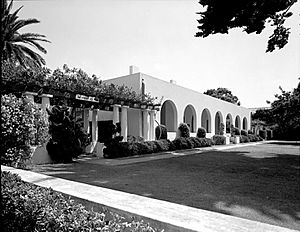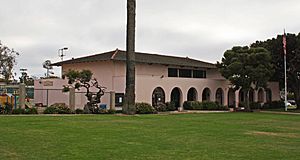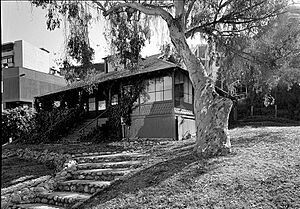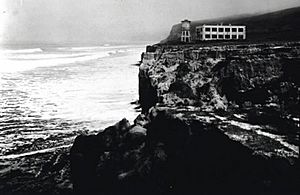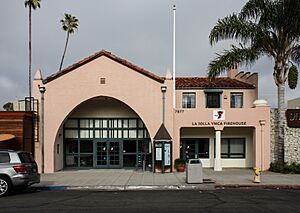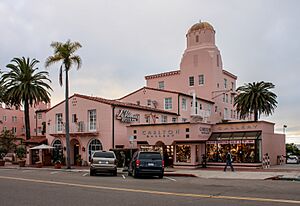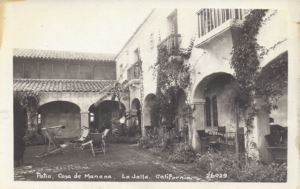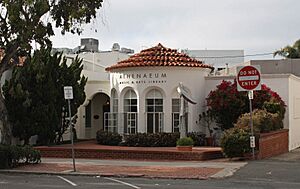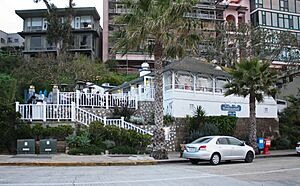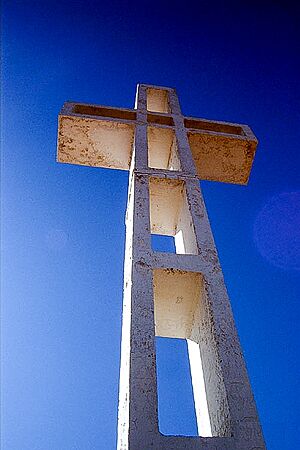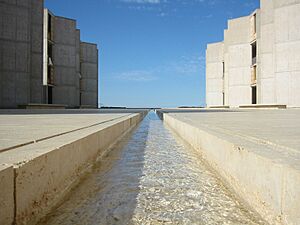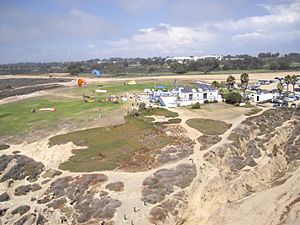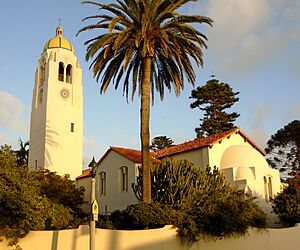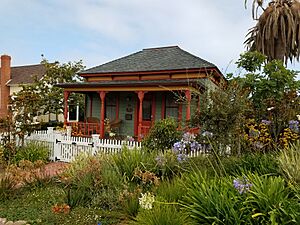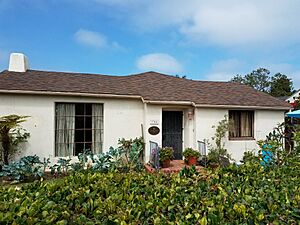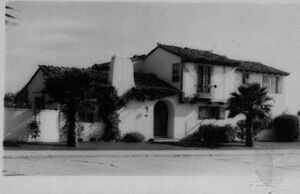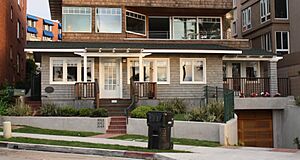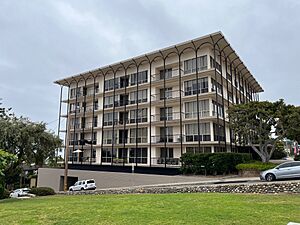List of San Diego Historical Landmarks in La Jolla facts for kids
Welcome to a list of amazing historical places in La Jolla and Torrey Pines! These are special buildings and areas that the City of San Diego decided to protect because they are important to history. Since 1967, the city has named over 1500 places as historical landmarks. This list focuses on the cool landmarks you can find in La Jolla and Torrey Pines.
Some of these places are so important that they are also recognized by the whole country! Four of them are on the National Register of Historic Places, and one, the George H. Scripps Memorial Marine Biological Laboratory, is a National Historic Landmark.
You'll find many buildings designed by a famous architect named Irving Gill. There's also the beautiful Torrey Pines Area. Plus, you'll see places linked to La Jolla's long history with science, like the George H. Scripps Memorial Marine Biological Laboratory and the Salk Institute for Biological Studies.

Exploring La Jolla's Landmarks
| Landmark # | Name | Picture | Address | Date Designated | What Makes It Special |
|---|---|---|---|---|---|
| 10 | Torrey Pines Area | Torrey Pines State Reserve 32°55′15″N 117°15′11″W / 32.92083°N 117.25306°W |
11/21/1969 | This coastal park is one of the wildest places on the Southern California coast. It has cliffs overlooking the beach and a lagoon for migrating birds. | |
| 79 | La Jolla Woman's Club | 715 Silverado St. 32°50′38″N 117°16′37″W / 32.84389°N 117.27694°W |
3/2/1973 | This clubhouse was designed by famous architect Irving Gill and built in 1914. | |
| 84 | Green Dragon Colony site | 1258-1274 Prospect St. 32°50′58″N 117°16′16″W / 32.84944°N 117.27111°W |
7/6/1973 | This was a group of 12 small coastal homes built by Anna Held Heinrich. It became a famous artists' colony. | |
| 86 | La Jolla Recreational Center | 615 Prospect St. 32°50′35″N 117°16′39″W / 32.84306°N 117.27750°W |
9/7/1973 | Built in 1915 by Ellen Browning-Scripps, this center was given to San Diego for La Jolla's children. It was designed by Irving Gill. | |
| 101 | Red Roost and Red Rest | 1187 and 1179 Coast Blvd. 32°50′59″N 117°16′21″W / 32.84972°N 117.27250°W |
1/3/1975 | Built in 1894, these are the oldest examples of Victorian beach cottages. One of them, Red Rest, unfortunately burned in November 2020. | |
| 119 | George H. Scripps Memorial Marine Biological Laboratory | 8602 La Jolla Shores Dr. 32°51′54″N 117°15′12″W / 32.86500°N 117.25333°W |
5/6/1977 | This is the oldest building in the U.S. used continuously for ocean research. It was built in 1909 as part of the Scripps Institution of Oceanography. | |
| 164 | La Jolla Fire Station Engine Company 13 | 7877 Herschel Ave. 32°50′48″N 117°16′22″W / 32.84667°N 117.27278°W |
6/30/1982 | This fire station was built in 1913. | |
| 166 | Wisteria Cottage | 780 Prospect St. 32°50′42″N 117°16′38″W / 32.84500°N 117.27722°W |
8/25/1982 | This cottage was built in 1904 and later updated in 1907 by architect Irving Gill. | |
| 204 | La Valencia Hotel | 1132 Prospect St. 32°50′55″N 117°16′25″W / 32.84861°N 117.27361°W |
1/14/1987 | Built in 1909, this hotel was first called Cabrillo Hotel. It was later renamed La Valencia West. | |
| 213 | Casa de Manana | 722, 809, 825 Coast Blvd. 32°50′47″N 117°16′40″W / 32.84639°N 117.27778°W |
12/2/1987 | This building was constructed in 1924 and designed by Edgar Ulrich. | |
| 228 | La Jolla Public Library | 1006 Wall St. 32°50′48″N 117°16′27″W / 32.84667°N 117.27417°W |
7/27/1988 | This library was built in 1921. | |
| 229 | The Athenaeum | 1008 Wall Street | 7/27/1988 | This building was constructed in 1956. | |
| 230 | Parker Office Building | 7917 Girard Ave. 32°50′49″N 117°16′27″W / 32.84694°N 117.27417°W |
7/27/1988 | Built between 1928 and 1930, this building was designed by Thomas Shepherd. | |
| 286 | Dr. Rodes House-Brockton Villa | 1235 Coast Boulevard | 8/22/1990 | This house was built in 1894 and is a companion to the Red Roof & Red Roost cottages. | |
| 294 | Colonial Inn project sites | 915, 921, 925, 927 Coast Boulevard | 1/30/1991 | These sites are part of the historic Colonial Inn project. | |
| 295 | Mount Soledad Park and Memorial Cross | Soledad Road 32°50′23″N 117°14′40″W / 32.83972°N 117.24444°W |
8/22/1990 | This area became a public park in August 1916. | |
| 304 | Salk Institute for Biological Studies | 10010 N. Torrey Pines Rd. 32°53′14″N 117°14′46″W / 32.88722°N 117.24611°W |
2/27/1991 | This famous research institute was founded in 1960 by Jonas Salk. Its modern campus was designed by Louis Kahn. | |
| 315 | Torrey Pines Gliderport | South of Torrey Pines Golf Course and Torrey Pines St. Pk.; west of Torrey Pines Scenic Dr. | 8/26/1992 | This glider airport started in 1928. Aviation pioneers like Charles A. Lindbergh used it. U.S. Army cadets also trained here during WWII. | |
| 357 | The Bishop's School Historic District | 7607 La Jolla Blvd | 5/27/1998 | This district includes several historic buildings like Bentham Hall (1910) and Scripps Hall (1910–11), many designed by Irving Gill. | |
| 364 | Geranium Cottage | 830 Kline Street | 8/26/1998 | This Craftsman style cottage was built in 1904. It was moved from its original location in 1914. | |
| 375 | Dr. Martha Dunn Corey Residence | 494 Arenas St. | 3/24/1999 | This Victorian house was built in 1909 for Dr. Martha Dunn Corey. It was moved in 2003. | |
| 503 | Fuelscher House | 7300-7304 Eads Avenue | 10/25/2001 | This Monterey eclectic style house was built in 1929. | |
| 560 | Henry and May Turner/Herbert Mann-Thomas Shepherd House | 391 Via del Norte | 11/22/2002 | This Spanish eclectic house was built in 1928 by architects Herbert J. Mann and Thomas Shepherd. | |
| 708 | F.M. Sheppard Duplex and House Rentals | 1046, 1049-1051 Coast Blvd. | 4/28/2005 | These Craftsman, shingle-style buildings were constructed in 1911. | |
| 992 | Park Prospect Condominiums/Russell Forester Building | 800 Prospect St. 32°50′44″N 117°16′36″W / 32.84556°N 117.27667°W |
4/28/2011 | These International Modernist condominiums were built in 1963 and designed by architect Russell Forester. | |
| 1103 | La Jolla Post Office | 1140 Wall St. 32°50′51″N 117°16′20″W / 32.84750°N 117.27222°W |
6/27/2013 | This Spanish Colonial Revival building was constructed in 1935. It features a public lobby mural called "Scenic View of the Village." |
See also



